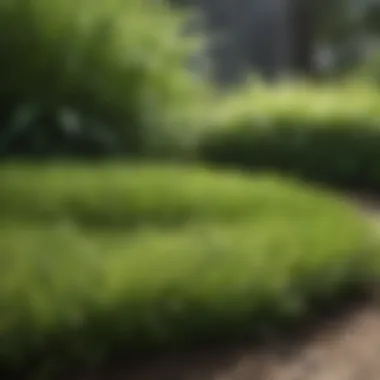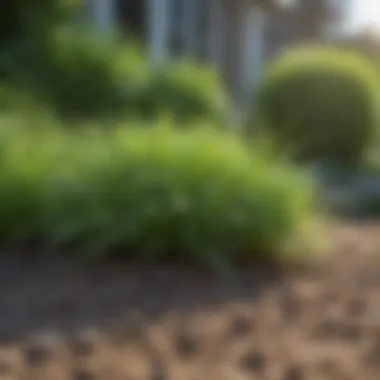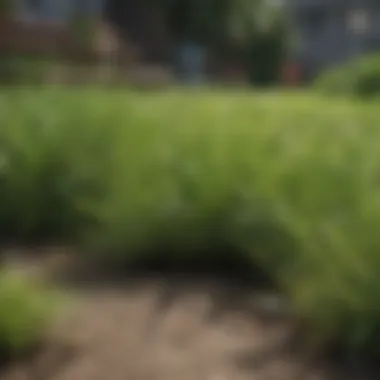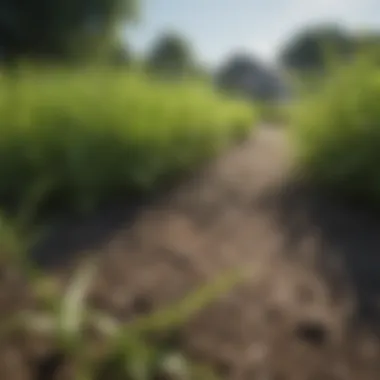Crabgrass Management: A Guide for Homeowners


Intro
Crabgrass is a common concern for homeowners and gardening enthusiasts alike. This resilient weed can invade lawns and disrupt the aesthetic appeal of outdoor spaces. Understanding its characteristics is crucial for effective management and prevention. This article dives deep into the essence of crabgrass, offering insights into its behavior, impact, and strategies for control and prevention.
One of the key aspects of crabgrass is its ability to thrive in various conditions. It prefers warm weather and can easily outcompete desirable grasses for nutrients and water. This adaptability makes it a formidable foe for those maintaining a pristine yard. Moreover, crabgrass spreads rapidly, often through seed production. A mature plant can generate thousands of seeds, ensuring its continued presence if not addressed promptly.
In this guide, we will explore how to identify crabgrass, its implications for garden aesthetics, and ecological health. We will also provide practical solutions for managing existing infestations and effective strategies to prevent future ones. This well-rounded approach aims to empower homeowners with the knowledge to tackle crabgrass confidently.
Intro to Crabgrass
Crabgrass is a common concern for many homeowners and gardening enthusiasts. Understanding its presence in your yard is crucial to maintaining a healthy lawn and garden. This section introduces crabgrass, explaining its behaviors and potential impacts on your outdoor space. Recognizing the necessity of this knowledge can greatly assist in managing this invasive species effectively.
Defining Crabgrass
Crabgrass, or Digitaria, is a type of annual weed that thrives in various climates. It is notably characterized by its wide, flat blades and hairy stems. This weed germinates mainly in warm weather, commonly in the spring and summer.
The primary species that homeowners encounter include smooth crabgrass and large crabgrass. Smooth crabgrass features a finer texture compared to large crabgrass. Both types can quickly overtake lawns, particularly when they are not kept in optimal health. Their growth can create patches of brown in your yard, which many find unappealing.
The Biology of Crabgrass
The life cycle of crabgrass is essential to understand for effective control and prevention. Crabgrass germinates when soil temperatures reach about 55°F. This weed grows rapidly, producing seeds that can survive in soil for several years. Each plant can produce thousands of seeds, contributing to its invasive nature.
Crabgrass prefers full sun and is often found in disturbed or bare soil areas. Once established, it competes aggressively with desirable grasses for resources such as nutrients, sunlight, and water. Recognizing this biological mechanism is vital. Control measures can be timed effectively based on the growth patterns and lifecycle characteristics discussed here.
Identifying Crabgrass in Your Yard
Identifying crabgrass in your yard is essential for effective management and prevention. Early detection allows homeowners to take swift action and minimize the negative impacts on lawn health. Crabgrass can outcompete desired grass species, leading to unhealthy turf and an unkempt appearance. Understanding its visual characteristics and growth patterns helps gardeners address infestations before they escalate. This section will guide you through the processes needed to recognize crabgrass, ensuring a healthy and vibrant yard.
Visual Characteristics
Crabgrass has distinct visual traits that can aid in its identification. This weed typically features wide, flat blades that exhibit a light green or grayish tint, especially when compared to other grass types. Leaves are often coarse to the touch and may have a semi-glossy surface. The plant grows low to the ground, forming a dense mat that can smother more desirable turf types.
Here are some important features to note:
- Growth Habit: Crabgrass usually grows as a bunch, rather than as a single plant. Look for clusters of stems emerging from a central point.
- Flowering: The plant produces small flowers that are generally greenish or purplish, appearing in a loose range above the leaves and stems.
- Root System: Crabgrass generally has shallow roots. This shallow root structure is part of why it can take over other grasses rapidly.
- Seed Production: Each crabgrass plant can produce thousands of seeds, and these can germinate easily, contributing to its invasiveness.
Being familiar with these traits empowers homeowners to distinguish crabgrass from other grass types.
Growth Patterns and Lifecycle
Understanding crabgrass's growth patterns and lifecycle is crucial for managing it effectively. Crabgrass is an annual plant, which means it completes its life cycle in one growing season. Typically, it germinates during warm weather, beginning in late spring to early summer when the soil temperature reaches around 55°F.


Key points about its lifecycle include:
- Germination: Seeds can remain dormant in the soil for a long time, waiting for ideal conditions to sprout.
- Growth Stages: Once it germinates, crabgrass quickly develops and spreads. The growth rate is accelerated in favorable conditions, easily overtaking slower-maturing desired grasses.
- Winter Hardiness: As an annual, crabgrass dies off in the fall, yet it leaves behind seeds that can survive until the next growing season.
- New Growth: In the spring, as temperatures rise, seeds from the previous year germinate, leading to new growth and potential infestation.
By understanding these details, homeowners can time their control efforts more accurately, preventing crabgrass from establishing itself and hinder overall lawn quality.
The Impact of Crabgrass on Lawn Health
Crabgrass not only complicates lawn aesthetics but also has significant repercussions on overall lawn health. Understanding this impact is essential for homeowners and gardening enthusiasts who wish to maintain a vibrant and healthy outdoor space. By comprehending how crabgrass influences the interaction between desired plants, soil quality, and overall environmental conditions, one can make informed decisions for effective management and prevention strategies.
Competition with Desired Plants
Crabgrass is known for its vigorous growth patterns, often outpacing the grasses and plants we intentionally cultivate. When crabgrass invades a lawn, it competes directly with desired species for vital resources, such as water, nutrients, and sunlight. This competition can lead to stunted growth of preferable plants. Homeowners may notice that areas invaded by crabgrass appear less vibrant and healthy compared to well-maintained sections of their yard.
The dense root system of crabgrass can overshadow young grass seedlings, making it difficult for them to establish themselves. This struggle limits their access to essential resources. If left unchecked, crabgrass can entirely dominate a lawn. The result is often patches of thin or even bare spots, leading to an unkempt appearance that detracts from the overall aesthetics of the landscape.
In addition to competition, crabgrass produces significant quantities of seeds, which create future problems. A single crabgrass plant can produce thousands of seeds that spread easily across the lawn, further complicating control efforts. Consequently, addressing crabgrass infestations promptly becomes crucial for maintaining the integrity of desired plants.
Effects on Soil Quality
The presence of crabgrass in a lawn can affect soil quality in various ways. First, as crabgrass grows, it disrupts the soil structure. Its roots can create channels in the soil, which might initially seem beneficial. However, over time, this disruption can lead to soil compaction and hinder the movement of air, water, and nutrients necessary for the health of grass and other plants.
Furthermore, crabgrass can deplete the soil of essential nutrients, particularly nitrogen. While traditional grasses may enrich the soil through their natural processes, crabgrass tends to absorb nutrients without returning them effectively to the earth. As a result, the nutrient balance of a garden or lawn may shift unfavorably, encouraging further weed growth and lessening the viability of desired plant species.
To highlight the importance of addressing crabgrass, consider the following points:
- It can lead to reduced biodiversity in a lawn, making it harder for various plant species to thrive.
- The overall aesthetic quality of the yard diminishes.
- Long-term management becomes increasingly difficult without intervention.
"Effective lawn management requires a deep understanding of the complex relationships between various plant species and their environment. Crabgrass serves as a powerful reminder of this interconnectedness."
Ultimately, homeowners should recognize that the presence of crabgrass signifies broader ecological issues within their lawn. Addressing crabgrass early allows for the promotion of a healthy, diverse, and visually pleasing yard.
Management Strategies for Crabgrass Control
Understanding how to manage crabgrass is crucial for maintaining a healthy lawn. Crabgrass can quickly overpower desired plants, leading to an unkempt yard and degraded soil quality. Thus, adopting effective management strategies is essential for homeowners who wish to preserve their outdoor spaces. The primary focus of management is to either remove existing crabgrass or prevent its further spread. Each method has its merits and drawbacks, which can greatly influence your choice of strategy based on your specific yard conditions and personal preferences.
Manual Removal Techniques
One of the simplest methods to control crabgrass is through manual removal. This method involves physically pulling out the crabgrass plants before they go to seed, which can significantly reduce their population. For effective manual removal, follow these steps:
- Timing: The best time for manual removal is when the soil is moist. This helps loosen the roots, making it easier to pull the plants out.
- Technique: Grasp the plant close to the base and pull straight up. Be careful to remove the entire root system. If some roots remain, the plant may regrow.
- Tools: Consider using a weeding tool or hand trowel for particularly stubborn plants. These can help to minimize surface disruption and prevent damage to surrounding grass.
While manual removal can be labor-intensive, it offers immediate results and minimizes chemical use.


Chemical Control Options
Chemical control options for crabgrass involve the use of herbicides. These can be effective but should be used with caution. Selecting the right product is vital, as improper use can harm desired grasses or pollute local waterways. Here are important considerations:
- Pre-emergent Herbicides: These are applied before crabgrass seeds germinate. They create a barrier that prevents seedling development. Common pre-emergents include Pendimethalin and Dithiopyr.
- Post-emergent Herbicides: For crabgrass that has already established, post-emergents can be effective. Products like Quinclorac or Fenoxaprop target existing crabgrass while sparing desired grass species.
Always read the labels for any chemical products. Ensure you follow application instructions to reduce harm to your lawn and surrounding environment.
Chemical methods can provide quick outcomes but require careful handling and awareness of their broader implications on lawn health and local ecology.
Organic Control Methods
For those who prefer a more environmentally-friendly approach, organic control methods are available. These options focus on enhancing lawn health and utilizing natural treatments. Consider the following:
- Mulching: Applying a layer of organic mulch can suppress crabgrass by blocking sunlight. This creates a less favorable environment for growth.
- Corn Gluten Meal: This natural pre-emergent can inhibit the germination of crabgrass seeds. It can be spread on your lawn when the soil temperature reaches around 55°F.
- Vinegar and Salt: For small patches of crabgrass, a solution of vinegar and salt can be sprayed on the plants. However, be cautious not to spray on desired plants, as this solution is non-selective.
Organic methods tend to be safer for the environment but may require repeated applications for effective control.
Implementing these management strategies can greatly improve the health and aesthetics of your lawn. Each approach has unique advantages that homeowners can utilize based on their circumstances and environmental values.
Preventing Crabgrass Infestation
Preventing crabgrass infestation is crucial for maintaining the aesthetic appeal and overall health of your yard. It is more effective and less labor-intensive than dealing with a full-blown invasion. Crabgrass is a resilient weed that thrives under various conditions. Deterring its growth is a matter of strategy and practices that focus on creating an environment unwelcoming to weeds. Rather than relying solely on reactive measures, an emphasis on prevention lends itself to long-term solutions, benefiting both the lawn and the local ecosystem.
Lawn Maintenance Practices
Regular lawn maintenance practices play a vital role in preventing crabgrass. Keeping your lawn well-maintained controls the weed population proactively. Implementing a few specific actions can reduce the chances of crabgrass taking hold. Here are key practices:
- Mowing Height: Keep your grass at a height of about three inches. Taller grass shades the soil, which can inhibit crabgrass seeds from germinating.
- Watering Routine: Water deeply but infrequently. This encourages deeper root growth in your lawn while making it difficult for annual weeds like crabgrass to thrive. Typically, aim for about 1 to 1.5 inches of water per week.
- Fertilization: Use a balanced fertilizer to promote the health of your grass. A well-fertilized lawn is more vigorous and can outcompete weeds.
- Aeration: Aerate your lawn once a year to alleviate soil compaction. This allows roots to grow deeper, enhancing grass health and reducing weed establishment.
Timing and Planning
Timing plays a critical role in preventing crabgrass. The effectiveness of your preventive measures often hinges on when they are implemented. Knowing the lifecycle of crabgrass can guide your planning. Here are some essential tips:
- Pre-Emergent Herbicides: Apply pre-emergent herbicides in early spring, before the soil temperature reaches 55 degrees Fahrenheit. This timing is crucial, as it coincides with the germination period of crabgrass seeds.
- Seasonal Mowing Schedule: Create a mowing schedule based on seasonal growth patterns. Increased growth in the spring months means more frequent mowing, aiding in the prevention of weed establishment.
- Soil Testing: Conduct soil tests in the fall to understand nutrient deficiencies or pH imbalances. This knowledge allows for timely intervention to promote healthy grass growth the following spring.
Importance of Healthy Lawn Practices
A healthy lawn is vital not only for appearance but also for the ecological balance of your yard. Here are a few principles to consider:
- Diversity: Encourage a diverse range of grass types and plants. Diversity in your lawn reduces the likelihood of a single weed, like crabgrass, becoming dominant, as varied species compete more effectively.
- Organic Matter: Increase organic matter in the soil by adding compost. Enhanced soil structure promotes healthy grass roots and suppresses weed growth.
- Education: Stay informed about lawn health and weed management. Being aware of common mistakes homeowners make can prevent crabgrass takeover.
Maintaining healthy lawn practices can create a natural barrier against weeds and contribute to long-term lawn health.


Sustainable Practices for Lawn Care
Sustainable lawn care is integral to maintaining the health of your yard while minimizing negative impacts on the environment. Homeowners increasingly recognize that ecological awareness is essential in managing lawns effectively. By adopting sustainable practices, individuals can enhance soil quality, reduce reliance on chemical inputs, and contribute to a more balanced ecosystem. Implementing these techniques not only serves to control crabgrass but also fosters the overall vitality of your outdoor space.
Soil Health and Fertility
Soil health is the foundation of any vibrant lawn. Healthy soil supports rich ecosystems that naturally reduce pest levels and enhance water retention. To improve soil fertility, homeowners should consider several key practices:
- Regular Testing: Conduct soil tests to determine nutrient levels and pH. This information helps in making informed decisions about amendments.
- Organic Matter Addition: Incorporate organic materials such as compost or aged manure. These substances improve soil structure and provide essential nutrients.
- Proper Aeration: Aerate the lawn to alleviate compacted soil, promoting better root growth and water infiltration.
- Mulching: Use grass clippings or shredded leaves as mulch around plants. This conserves moisture and adds organic matter back into the soil.
By focusing on these elements, homeowners can create a soil environment where beneficial microorganisms flourish, ultimately improving the resilience of the lawn against invaders like crabgrass.
Natural Pest Control Methods
Employing natural pest control methods is another effective strategy for sustainable lawn care. Instead of relying solely on chemical herbicides, which can degrade soil health, consider these alternative approaches:
- Beneficial Insects: Introduce or encourage beneficial insects such as ladybugs and lacewings. These predators help keep pest populations in check without harming the soil.
- Companion Planting: Utilize plants that naturally repel harmful pests. For example, planting marigolds can deter nematodes and aphids.
- Organic Herbicides: Use products derived from natural sources. Vinegar and corn gluten meal are popular options for managing crabgrass while remaining environmentally friendly.
- Integrated Pest Management (IPM): Adopt a holistic approach that combines various strategies. This includes monitoring pest populations and applying treatments when necessary, balancing ecological goals with practical lawn care.
Implementing these natural pest control methods enhances the health and biodiversity of your lawn while effectively addressing crabgrass issues.
"Adopting sustainable practices not only fosters a healthier lawn but also nurtures the environment, inviting resilience against pervasive weeds like crabgrass."
The End
The conclusion serves as a vital section in this guide, summarizing the substantial insights gathered about crabgrass. Understanding its characteristics, impacts, and control methods is essential for homeowners and gardening enthusiasts alike. Knowledge of crabgrass allows individuals to take proactive measures against its invasion, ensuring a more aesthetically pleasing and ecologically balanced yard.
Recap of Key Points
Throughout this article, we discussed several crucial aspects of crabgrass. The following points summarize the most significant findings:
- Defining Crabgrass: Recognized as a common lawn pest, crabgrass thrives in sunny areas and can spread rapidly if not managed effectively.
- Identifying Crabgrass: Familiarity with its visual characteristics aids in early detection, which can significantly alter the outcome in controlling its spread.
- Impact on Lawn Health: The invasive nature of crabgrass leads to competition for nutrients and water, adversely affecting the health of desirable plants.
- Management Strategies: A combination of manual removal, chemical control, and organic options provides a repertoire for tackling crabgrass effectively.
- Prevention Techniques: Implementing proper lawn maintenance, timing strategies, and promoting soil health can mitigate crabgrass infestations.
- Sustainable Practices: The incorporation of methods that prioritize soil fertility and natural pest control can lead to healthier lawns in the long run.
Encouragement for Lawn Enthusiasts
It can feel challenging to deal with weeds like crabgrass. However, persistence and informed actions yield significant benefits. Take pride in nurturing your lawn, knowing you can effectively manage and prevent crabgrass by adopting the strategies outlined in this article. Every action contributes to a healthier outdoor space, not just for aesthetics, but for ecological vitality as well. Investing time into creating and maintaining a diverse lawn pays off with thriving plants and fewer invasive species. Always consider the health of your soil and choose sustainable practices that support long-term lawn care. Your dedication will not only enhance your yard's beauty but also promote a healthier environment for years to come.
Further Reading on Crabgrass
Books, articles, and online resources can offer further insights into crabgrass biology and control methods. Reading scientific literature not only deepens your understanding but also exposes you to the latest research on effective management practices. For example, consulting resources like publications available through the Royal Horticultural Society or American Horticultural Society can be invaluable. These platforms present evidence-based strategies for controlling crabgrass, tailored to different climates and soil types. They often contain visuals that can help in identifying crabgrass in various stages of growth.
Additionally, websites like Wikipedia and Britannica provide foundational knowledge and contextual information about the plant’s characteristics and lifecycle. Engaging with these resources can empower homeowners to make informed choices about crabgrass management and prevention techniques.
Expert Organizations and Contacts
Connecting with experts in the field of horticulture can yield practical benefits. Organizations such as the National Association of Landscape Professionals or local university extension services offer guidance and support for managing crabgrass. These entities often provide workshops, training sessions, and hands-on demonstrations that help in understanding effective strategies firsthand.
Establishing contact with local gardening clubs or online forums like Reddit can help as well. Participants often share personal experiences and offer advice on dealing with crabgrass infestations specific to your geographic area. Furthermore, social media groups on platforms like Facebook can function as learning communities where members share tips and tricks for managing various lawn issues, including crabgrass.
"Knowledge is power. The more you know about crabgrass, the better equipped you will be to combat it."



